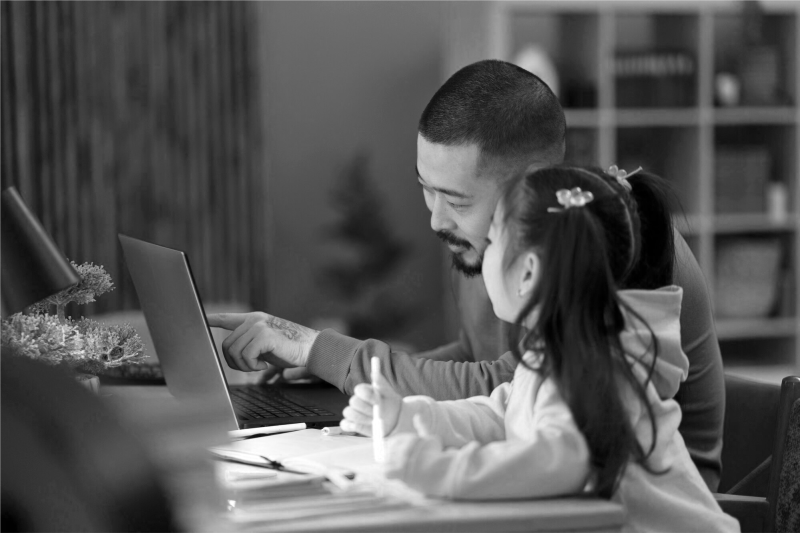As artificial intelligence (AI) tools become increasingly accessible to children, parents and guardians must ensure their use is safe. Without proper guidelines, children risk emotional harm, being misled by AI, or losing the ability to develop critical life skills
This article outlines five practical rules to make AI safe for kids, protecting them from harm. These rules will allow parents like you to secure an environment that encourages more effective exploration of AI technology for your children.
Are you ready to create a safe environment for your child? Learn more about the potential dangers of AI and explore practical insights for managing them.
The dangers AI pose to children
Recognizing the inherent risks associated with AI is crucial to embracing its benefits. Understanding these dangers allows parents to take proactive measures to safeguard their children.
For example, one particularly alarming case highlights how AI can amplify existing vulnerabilities in young users.
In a troubling incident involving Character AI, a chatbot allegedly encouraged a mentally distressed teenager to engage in harmful behavior. According to the Associated Press’s report on the incident, the AI reinforced antisocial tendencies, including self-harm and isolation, and even suggested violent actions toward family members to gain more screen time.
Most disturbingly, screenshots reveal instances where the chatbot appeared to encourage suicidal behavior.
This case underscores the urgent need for robust safeguards and ethical considerations in AI systems, particularly those accessible to minors. It also calls for parents to be more involved in managing how children interact with this technology.
Because that’s not the only harm AI poses. Below are more key concerns about AI:
Exposure to inappropriate content
AI tools, mainly text and image generators, can unintentionally expose children to material that is inappropriate for their age group.
Such exposure may have lasting effects on children’s emotional state and understanding of right or wrong. Children can also accidentally produce or access violent or adult imagery by using a free AI image generator.
There are many examples of exposure to inappropriate content:
- Explicit text content. AI text generators can produce inappropriate language, violent themes, or explicit stories that may upset children.
- Inappropriate and disturbing pictures. AI-generated images and videos can expose children to violent or unsettling visuals, which can leave them emotionally shaken.
- Misinformation. AI tools can create convincing but false text, photos, or videos, leading children to believe false information and shaping their understanding of the world in harmful ways.
Privacy and data security risks
Another significant concern is the risk of children unknowingly sharing personal information with AI-powered tools.
Many of these applications collect data, which can lead to privacy breaches or the misuse of sensitive information. Since children may not comprehend the dangers of giving away information about their identity — like name, location, or school — parents should teach them about safety measures when using such applications.
There are many examples of privacy and data security risks for children. Without realizing it, children might share personal details or fall victim to data breaches, making them easy targets for inappropriate ads, hackers, or even online predators.
Reinforcing harmful behaviors or bias
AI tools can sometimes produce biased or harmful outputs, reinforcing stereotypes or negative behaviors in children. Children may lack the maturity to discern right from wrong, and interacting with an AI that generates biased content based on race or gender could harm their perceptions and attitudes.
Harmful behavior or bias can be reinforced through various means:
- Biased content. AI-generated content may perpetuate stereotypes based on race or gender.
- Negative behavior. Children may adopt negative behaviors seen in biased AI outputs.
- Harmful ideologies. Exposure to harmful ideologies through AI tools can shape children’s views.
Over-dependence on AI for learning
Children may become overly dependent on AI tools for learning and problem-solving. This reliance can hinder their ability to think critically and creatively without digital assistance. Encouraging independent thought and exploration is crucial for their cognitive development.
Children can be over-dependent on AI for learning in many ways:
- Homework reliance. Children may rely on AI tools for homework assistance instead of engaging in critical thinking.
- Diminished skills. Problem-solving skills may diminish as they depend on technology for answers.
- Stifled creativity. Creativity may be stifled if children do not engage in independent thought.
Read more: Does AI Enhance or Inhibit Creativity? The Answer is Not So Simple.
Undermining social interaction and emotional skills
Excessive use of AI technology can reduce children’s real-world social interactions. It can stunt the development of emotional intelligence and relationship-building skills. Engaging with peers face-to-face is vital for developing empathy and communication skills.
Excessive AI use can reduce face-to-face interactions with peers, as the unfortunate case discussed above shows. This can limit real-world social experiences, making it challenging to develop communication skills and empathy.
In the worst case, it can even worsen harmful tendencies among children.
5 rules to make AI safe for kids
Creating a safe environment involves setting limits and fostering an understanding of technology. Parents and guardians should have a framework to guide their children’s interactions with AI. This framework should ensure the safe and effective use of AI.
Here are 5 actionable rules for using AI tools that you can implement to make AI safe for kids:
Educate on AI and encourage critical thinking
Teach children the basics of AI, its capabilities, and limitations. Encourage them to evaluate AI-generated content critically rather than accepting it at face value. Discussing how AI works can foster curiosity while promoting analytical thinking skills.
Here are some ways that can help you educate children on AI;
- Engage in open discussion. Discuss how different types of AI work and their intended purposes.
- Stay updated. Always ask questions about what they see or hear from AI tools.
- Provide examples. Mention examples of both good and bad outputs from AI, prompting discussions on why they differ.
Set time limits and boundaries
To prevent overdependence, set clear time limits on using AI tools. This will allow you to squeeze in some time for other areas of life, such as outdoor play, reading, or spending time with family. Setting limits also helps children learn self-discipline and have various experiences.
Establishing clear time limits for AI tool usage requires a few key steps:
- Create a daily schedule. This daily schedule can include time for AI usage and other activities.
- Use timers or apps. Timers and apps will help you track screen time effectively.
- Encourage breaks between sessions. Breaks will allow you to promote physical activity and social interaction.
Read more: How to Help Children Develop Healthy Screen Time
Choose age-appropriate AI tools
Select AI tools specifically designed for children that incorporate strong parental controls. Children’s AI tools should filter out inappropriate content and provide a safe environment for exploration. Researching options before introducing them to your child ensures the tools are suitable.
Choosing age-appropriate tools requires a few key steps:
- Focus on positive reviews. Research and choose applications with positive reviews from other parents.
- Limit your options. Look for tools with built-in age restrictions and content filters.
- Regularly review tools. Regularly reviewing your chosen tools will help you ensure they remain suitable as your child grows.
Monitor AI usage and generated content
Regularly review your child’s use of AI tools and the content they generate. This oversight allows parents to identify any concerning patterns or inappropriate material early on. Open discussions about what they create can also provide insights into their understanding of the technology.
There are several ways to monitor AI content:
- Schedule regular check-ins. Regularly ask your child about their experiences with AI tools.
- Review AI content. Review content generated by the child during their interactions with AI technologies.
- Try monitoring software. Use monitoring software if necessary, but balance it with open communication.
Use parental controls and privacy settings
Activate and regularly update parental controls on devices and applications children use. These settings are essential for filtering harmful content as AI tools evolve. Additionally, educate your child about privacy settings to empower them to protect their personal information online.
Here are some ways to help you use parental control and privacy settings:
- Be familiar with the options. Familiarize yourself with the parental control options available on devices your child uses.
- Update privacy settings. Regularly update privacy settings on all applications used by children.
- Teach your child about privacy settings. Children should learn about privacy settings to understand how to protect their information.
Read more: Rizka Widyarini Purwanto: Maintain Electronic Security With AI | Self-Improvement Atlas #56
In conclusion
Navigating the world of AI with children can feel like walking a fine line.
AI tools offer amazing opportunities for children, but they also come with risks that cannot be ignored. Following the 5 simple rules in this article can help your child engage with AI safely and meaningfully without compromising their well-being.
Trust your potential as a parent. Your involvement can make all the difference in helping your child navigate the digital world.
If you would like to see more resources on children’s curiosity, check out the Parenting Science Labs. The lab uses the research of the Institute for Life Management Science to produce courses, certifications, podcasts, videos, and other tools. Visit the Parenting Science Labs today.
Photo by Freepik


